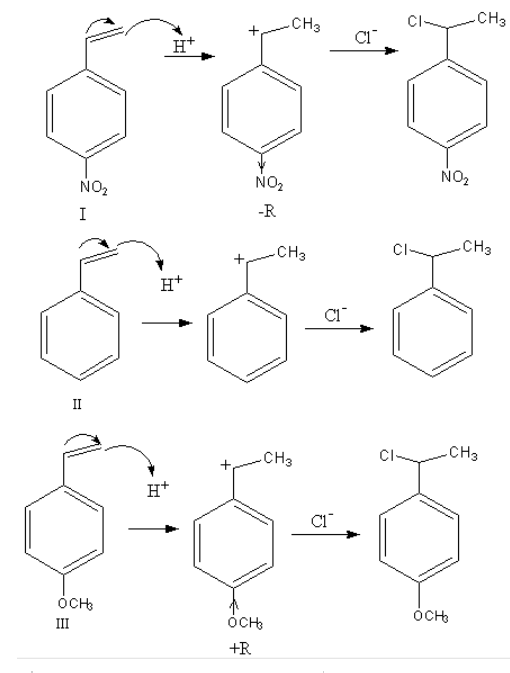Answer
405.6k+ views
Hint: The reactivity of reactants is decided on the basis of the stability of the intermediate. The more stable the intermediate, the more reactive the reactant. The substituents attached to the reactant affect the stability of the intermediate.
Complete Step by step answer: The reaction of an alkene with hydrochloric acid takes place in two steps. In the first step carbocation forms and in the second step product alkyl chloride forms. The reactivity of reactants is decided on the basis of the stability of the intermediate.
Nucleophilic attack of an alkene on the acid takes place so, alkene gets protonated and a carbocation form. On this carbocation the chloride ion attacks and forms alkyl chloride.
The reaction of each reactant is as follows:

As during the reaction, a carbocation forms so, the rate of reaction depends upon the stability of the carbocation. The more stable the carbocation the more will be the rate of reaction.
The stability of carbocation depends upon the substituents attached to the benzene ring.
$ - {\text{OC}}{{\text{H}}_{}}$ is an electron-donating group so, it stabilizes the carbocation so, the reactivity of the reactant- III will be highest.
$ - {\text{N}}{{\text{O}}_2}$ is an electron-withdrawing group so, it destabilizes the carbocation so, the reactivity of the reactant- II will be lowest.
So, the decreasing order of reactivity with HCl is as follows:
III > II > I
Therefore, option (B) III > II > I, is correct.
Note: The ${{\text{S}}_{\text{N}}}1$ mechanism, a carbocation form in first step. The carbocation is the intermediate of ${{\text{S}}_{\text{N}}}1$types reactions. Carbocation is an electron-deficient species. So, the electron-donating group stabilizes the carbocation. Electron-withdrawing groups destabilize the carbocation. The more the number of electron-donating groups the more stable the carbocation will be. Here, all the carbocations are secondary. If all carbocations are different then the stability order of the carbocations, ${1^ \circ } < \,{2^ \circ }\, < \,{3^ \circ }$.
Complete Step by step answer: The reaction of an alkene with hydrochloric acid takes place in two steps. In the first step carbocation forms and in the second step product alkyl chloride forms. The reactivity of reactants is decided on the basis of the stability of the intermediate.
Nucleophilic attack of an alkene on the acid takes place so, alkene gets protonated and a carbocation form. On this carbocation the chloride ion attacks and forms alkyl chloride.
The reaction of each reactant is as follows:

As during the reaction, a carbocation forms so, the rate of reaction depends upon the stability of the carbocation. The more stable the carbocation the more will be the rate of reaction.
The stability of carbocation depends upon the substituents attached to the benzene ring.
$ - {\text{OC}}{{\text{H}}_{}}$ is an electron-donating group so, it stabilizes the carbocation so, the reactivity of the reactant- III will be highest.
$ - {\text{N}}{{\text{O}}_2}$ is an electron-withdrawing group so, it destabilizes the carbocation so, the reactivity of the reactant- II will be lowest.
So, the decreasing order of reactivity with HCl is as follows:
III > II > I
Therefore, option (B) III > II > I, is correct.
Note: The ${{\text{S}}_{\text{N}}}1$ mechanism, a carbocation form in first step. The carbocation is the intermediate of ${{\text{S}}_{\text{N}}}1$types reactions. Carbocation is an electron-deficient species. So, the electron-donating group stabilizes the carbocation. Electron-withdrawing groups destabilize the carbocation. The more the number of electron-donating groups the more stable the carbocation will be. Here, all the carbocations are secondary. If all carbocations are different then the stability order of the carbocations, ${1^ \circ } < \,{2^ \circ }\, < \,{3^ \circ }$.
Recently Updated Pages
How many sigma and pi bonds are present in HCequiv class 11 chemistry CBSE

Why Are Noble Gases NonReactive class 11 chemistry CBSE

Let X and Y be the sets of all positive divisors of class 11 maths CBSE

Let x and y be 2 real numbers which satisfy the equations class 11 maths CBSE

Let x 4log 2sqrt 9k 1 + 7 and y dfrac132log 2sqrt5 class 11 maths CBSE

Let x22ax+b20 and x22bx+a20 be two equations Then the class 11 maths CBSE

Trending doubts
Fill the blanks with the suitable prepositions 1 The class 9 english CBSE

At which age domestication of animals started A Neolithic class 11 social science CBSE

Which are the Top 10 Largest Countries of the World?

Give 10 examples for herbs , shrubs , climbers , creepers

Difference between Prokaryotic cell and Eukaryotic class 11 biology CBSE

Difference Between Plant Cell and Animal Cell

Write a letter to the principal requesting him to grant class 10 english CBSE

Change the following sentences into negative and interrogative class 10 english CBSE

Fill in the blanks A 1 lakh ten thousand B 1 million class 9 maths CBSE




